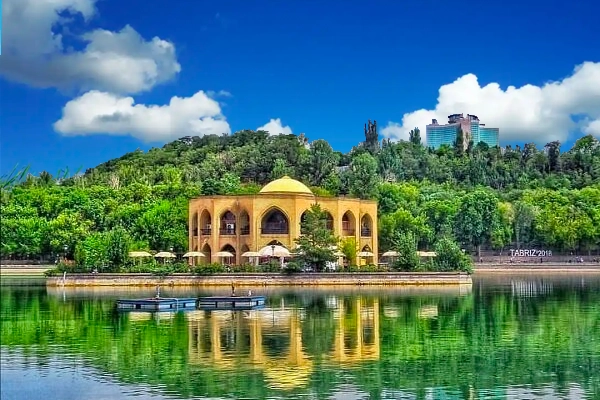
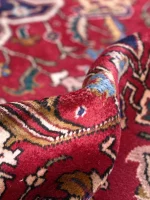
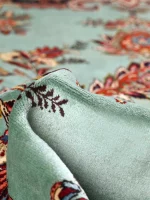
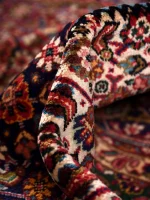
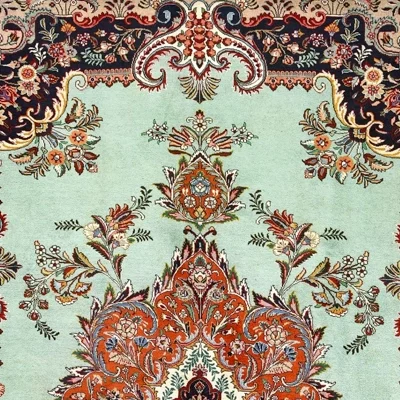
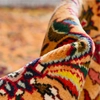
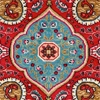
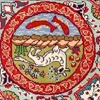
Are you passionate about luxury and impeccable interior design? Then delve into our exclusive assortment of Persian Tabriz carpets curated by Reza Derakhshesh, a renowned expert in Persian carpet craftsmanship. These exceptional and opulent pieces are certain to elevate your home decor to unparalleled heights. Allow me to share more about why you should consider acquiring a Persian Tabriz carpet from CarpetShip collection.
Persian Tabriz carpets epitomize luxury and individuality in home decor. The terms “unique and luxurious” associated with Tabriz carpets encompass the imaginative diversity of patterns and the meticulous coordination of colors by highly skilled master artisans, all while adhering to stringent standards. Crafted by hand with only the finest materials, these carpets are celebrated for their unparalleled quality and durability. Their intricate designs and exquisite patterns transform them into magnificent works of art that can instantaneously enhance the ambiance of any room.
However, the allure of Persian Tabriz carpets extends beyond aesthetics. Investing in one of these masterpieces can also be a shrewd financial decision. These carpets have a rich history of being cherished and sought after, which means their value is likely to appreciate over time. By investing in a Persian Tabriz carpet now, you may potentially enjoy a substantial return on your investment in the future.
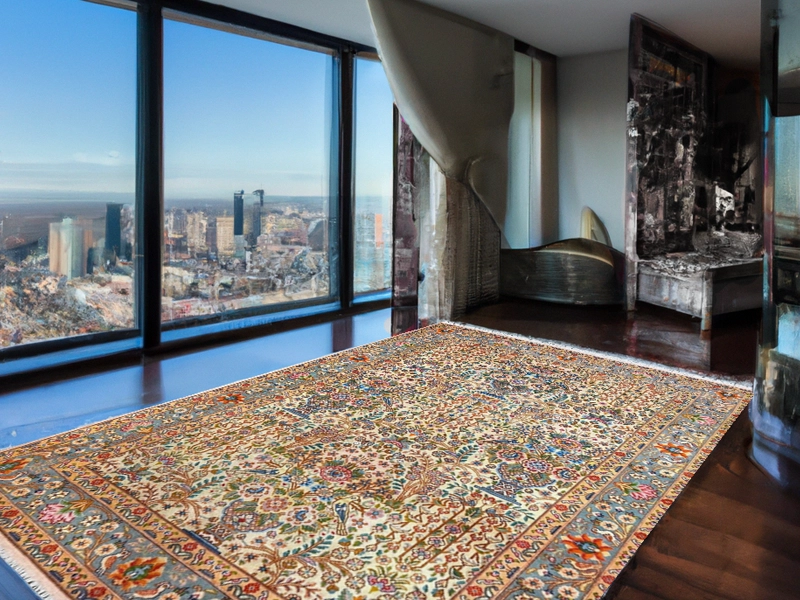
When you acquire a Persian Tabriz carpet from us, rest assured that you are obtaining an utterly unique piece (except for those specifically ordered in pairs, which are sold as pairs). Each hand-knotted Persian Tabriz carpet is meticulously crafted by hand, ensuring that no two are precisely alike. This uniqueness guarantees that your Persian Tabriz carpet will serve as a conversation piece and the focal point of any room.
Finally, we take immense pride in our collection of Persian Tabriz carpets and assure you that each one exemplifies the highest quality. The concept of high quality extends to the steadfast colors that, over several years of use, become even more vibrant, transparent, and beautiful, particularly in antique Persian Tabriz carpets. We meticulously select each carpet for our collection, ensuring that it upholds our rigorous standards for craftsmanship and design. When you purchase a Persian Tabriz carpet from us, you can have absolute confidence that you are acquiring an exceptionally distinguished piece.
We guarantee that each carpet has been meticulously maintained throughout its history, possesses an outstanding level of quality relative to its grade and range, and is currently presented to discerning customers without any defects or issues.
So, if you aspire to elevate your home decor with a luxurious and exclusive masterpiece, we warmly invite you to explore our collection of Persian Tabriz carpets by CarpetShip. Whether you seek a bold and vibrant carpet to make a statement or a subtle, understated piece to tie a room together, we offer an array of options to suit every taste. Do not delay – commence your exploration of our collection today and discover the perfect Persian Tabriz carpet for your home.
The history and art of carpet weaving in Tabriz can be traced back to the second half of the 15th century and the early 16th century when Islamic designs, animal motifs, and occasionally human figures were used. From the 17th century onwards, after Iranian carpets were exported abroad, Tabriz artists began producing a wide variety of carpets, incorporating the tastes of European and American people, and successfully capturing the markets of those countries.
Throughout history and to this day, Tabriz has been a significant and influential center for carpet weaving in Iran, boasting a glorious reputation. The carpets from this region adorn prestigious museums worldwide and are sought after by enthusiastic collectors globally.
For the past 40 years and up until now, skilled Tabriz weavers have excelled in producing delicate silk floral carpets in quarter medallion designs at scales of 50, 60, and 70 Raj. They have sometimes used silk for the pile of the carpets as well, adhering to the necessary standards in coloration and showcasing the mastery of skilled dyers.
A Tabriz carpet has a simple and quadrangular design, with four corners, and the longitudinal warp threads also contribute to the foundation of the carpet. The carpet artist knots the colored, dyed wool according to the design around these warp threads using the Turkish knot (as shown in video), which is customary in Tabriz carpets. Then, a complete row of knots is followed by placing weft threads made of cotton or wool called “pood” over the row and firmly securing the carpet weaving using a tool called a “shane.” This process continues until the carpet is completed.
The value of an authentic handwoven Tabriz carpet from Iran lies in several months of painstaking and precise work, consisting of thousands of knots, resulting in an artistic and enduring masterpiece. It is worth mentioning that, for the strength of the carpet’s edges, several warp threads are twisted in the selvedge using the “khammeh” technique, reinforcing the carpet’s edges.
The major wool used in Tabriz carpets is primarily sourced from Maku, known for its high-quality and durable wool. In the past and up until now, it was also supplied from regions such as Mahabad, Moghan Plain, Khoy, and Salmas.
Approximately 40 years ago and to this day, a combination of “kork,” which refers to the soft wool on the sheep’s body, known for its delicacy, has been used. Additionally, a blend of kork and natural silk, as well as the use of warp and weft made of either cotton or natural silk, has been employed.
Of course, by “antique Tabriz carpets,” we refer to carpets that are between 30 to 50 years old, and it mostly depends on several factors:
The predominant sizes for Tabriz carpets are typically produced and available in dimensions of:
with larger sizes being relatively limited in availability.
The knot count in Tabriz carpets is calculated based on the number of knots per 7 centimeters width. Typically, Tabriz carpets have approximately 25, 40, 50, or 60 knots per 7 centimeters. There are also rare and limited cases where carpets with approximately 70 or 80 knots can be found. As the knot count increases, the carpet becomes finer, and typically, silk is used in carpets with a knot count of 50 or higher. The amount of silk used is proportionate to the higher knot count. For example, usually a carpet with a knot count of 60 will have more silk used compared to a carpet with a knot count of 50.
The master designers in Tabriz carpets each have their own unique style and brand, creating their own distinctive artistic creations through their creativity, without copying from elsewhere. Tabriz carpets are predominantly produced and designed by experienced master designers who consider factors such as the best quality of fibers and dyeing while maintaining the necessary standards to achieve high color stability. The carpets are meticulously crafted by skilled artisans who execute the Turkish knot in a proper manner, ensuring that the knots are uniform and regular when placed side by side. This results in Tabriz carpets having a special radiance and transparency, without being dull or matte. The execution of color harmony is also achieved with a wide variety.
Due to variations in the speed and skill of weavers and the complexity of the design and knotting techniques used, the production process can differ. For example, Tabriz rugs are woven using the Turkish knot with a hook. A Tabriz rug measuring 300*200 centimeters with a knot count of 40 Raj (meaning 40 knots per 7 centimeters) takes approximately 392 days to complete, considering that a skilled weaver can tie around 5,000 knots per day. It is evident that more intricate rugs, especially those made with natural silk or a combination of wool and silk, require more time to weave.
The initial step involves the talented designer creating the rug’s pattern. The raw materials used include wool or cotton, and if necessary, a quantity of silk depending on the intricacy of the rug. The colors depicted in the pattern are derived from the following components:
Each of these elements contributes to the creation of a finely crafted Tabriz rug with a unique artistic allure.
In fact, from the second half of the 15th century and the beginning of the 16th century AD, Tabriz rugs predominantly featured Islamic, animal, and occasionally human motifs. Starting from the 17th century, Tabriz artists began producing carpets with a wide variety of designs, influenced by the tastes of European and American consumers. They were successful in exporting Tabriz rugs through Tabriz merchants, primarily via Istanbul, which served as their base in the past.
Not only Tabriz rugs, but any handmade woolen rug is best placed in an area with limited air circulation to prevent moth damage. It is advisable to expose the rug to fresh air for 3 to 4 hours once a year. If the rug is not being used for a period of time, it should be stored with naphthalene or tobacco to repel pests.
Care should be taken to prevent excessive wear of the rug during prolonged use. If the pile of the rug becomes significantly worn, it can be used in less trafficked areas.
In case of spills such as soft drinks, tea, or coffee, it is important to immediately remove the liquid from the rug and prevent it from seeping in. Delaying the cleaning process can make it more difficult to remove the stain completely.
Typically, Tabriz rugs are designed in a quarter medallion format and feature intricate floral and arabesque patterns. One notable aspect is the uniformity and harmony of the spaces within the overall rug design, with the artistic value primarily attributed to the pattern and color.
In fact, they have combined elements of geometric and tree-of-life designs from Kerman, Isfahan, and Kashan with Tabriz patterns, which are still widely used in this style today.
Get informed about exclusive sales , free delivery and discount coupons %